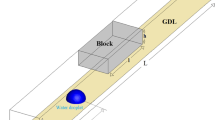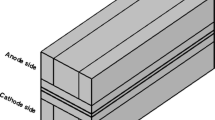Abstract
In this paper, a parametric study of anode channel clogging of a proton exchange membrane fuel cell (PEMFC) is presented using the numerical volume of fluid method. The droplet size distribution in the present research is considered close to reality. Therefore, three droplets with different sizes are initially placed on the anode channel wall. The droplet sizes are obtained based on the distribution of the saturated liquid water along the whole channel under a specific working condition and the amount of condensed water in the channel, using the PEMFC code. Finally, the dynamic behavior of the droplets is investigated and compared to that of a single droplet with the same total volume. Numerical results show that, in the case of three droplets, the droplets coalesce during the removal time and form a larger droplet. Also, the droplets gradually spread over the channel walls and eventually reach the upper corners of the channel and form liquid slugs. Then, the slugs move slowly toward the channel outlet, and after a while, their shapes and positions are fixed and cause the channel clogging. Changing the number of droplets does not significantly change the time of channel clogging. The numerical results show that the time-averaged pressure drop of three droplets is about 85% less than that of a single droplet.















Similar content being viewed by others
References
Ge S, Wang CY (2007) Liquid water formation and transport in the PEFC anode. J Electrochem Soc 154:B998–B1005
Lee D, Bae J (2012) Visualization of flooding in a single cell and stacks by using a newly-designed transparent PEMFC. Int J Hydrogen Energy 37:422–435
Iranzo A, Boillat P, Biesdorf J, Salva A (2015) Investigation of the liquid water distributions in a 50 cm2 PEM fuel cell: effects of reactants relative humidity, current density, and cathode stoichiometry. Energy 82:914–921
Wong K, Loo K, Lai Y, Tan SC, Chi KT (2011) A theoretical study of inlet relative humidity control in PEM fuel cell. Int J Hydrogen Energy 36:11871–11885
O’Rourke J, Ramani M, Arcak M (2009) In situ detection of anode flooding of a PEM fuel cell. Int J Hydrogen Energy 34:6765–6770
Sergi JM, Kandlikar SG (2011) Quantification and characterization of water coverage in PEMFC gas channels using simultaneous anode and cathode visualization and image processing. Int J Hydrogen Energy 36:12381–12392
Anderson R, Blanco M, Bi X, Wilkinson DP (2012) Anode water removal and cathode gas diffusion layer flooding in a proton exchange membrane fuel cell. Int J Hydrogen Energy 37:16093–16103
Ding Y, Bi H, Wilkinson D (2011) Three dimensional numerical simulation of gas–liquid two-phase flow patterns in a polymer–electrolyte membrane fuel cells gas flow channel. J Power Sources 196:6284–6292
Jo JH, Kim WT (2015) Numerical simulation of water droplet dynamics in a right angle gas channel of a polymer electrolyte membrane fuel cell. Int J Hydrogen Energy 40:8368–8383
Ferreira RB, Falcão DS, Oliveira VB, Pinto AMFR (2017) 1D + 3D two-phase flow numerical model of a proton exchange membrane fuel cell. Appl Energy 203:474–495
Ferreira RB, Falcão D, Oliveira V, Pinto A (2015) Numerical simulations of two-phase flow in an anode gas channel of a proton exchange membrane fuel cell. Energy 82:619–628
Hou Y, Zhang G, Qin Y, Du Q, Jiao K (2017) Numerical simulation of gas liquid two-phase flow in anode channel of low-temperature fuel cells. Int J Hydrogen Energy 42:3250–3258
Chen ZX, Ingham DB, Ismail MS, Ma L, Hughes KJ, Pourkashanian M (2018) Dynamics of liquid water in the anode flow channels of PEM fuel cells: a numerical parametric study. J Energy Inst. https://doi.org/10.1016/j.joei.2018.10.016
Mohammadzadeh K, Kaldehi BJ, Jazmi R, Khaleghi H, Maddahian R, Shirani E (2019) A numerical model for estimation of water droplet size in the anode channel of a proton exchange membrane fuel cell. J Energy Storage 26:101021
Mohammadzadeh K, Khaleghi H, Abolfazli H, Seddiq M (2018) Effects of gas cross-over through the membrane on water management in the cathode and anode sides of PEM fuel cell. J Appl Fluid Mech 11:861–875
Vafaei S, Podowski M (2005) Analysis of the relationship between liquid droplet size and contact angle. Adv Coll Interface Sci 113:133–146
Martin J, Oshkai P, Djilali N (2005) Flow structures in a U-shaped fuel cell low channel: quantitative visualization using particle image velocimetry. J Fuel Cell Sci Technol 2:70–80
Youngs DL (1982) Time-dependent multi-material flow with large fluid distortion. In: Morton KW, Baines MJ (eds) Numerical methods for fluid dynamics. Academic Press, New York, pp 273–285
Shirani E, Ashgriz N, Mostaghimi J (2005) Interface pressure calculation based on conservation of momentum for front capturing methods. J Comput Phys 203:154–175
Lafaurie B, Nardone C, Scardovelli R, Zaleski S, Zanetti G (1994) Modeling merging and fragmentation in multiphase flows with SURFER. J Comput Phys 113:134–147
Lide DR (2012) CRC handbook of chemistry and physics. CRC, Boca Raton
Manso A, Marzo F, Barranco J, Garikano X, Mujika MG (2012) Influence of geometric parameters of the flow fields on the performance of a PEM fuel cell. A review. Int J Hydrogen Energy 37:15256–15287
Heidary H, Kermani MJ, Advani SG, Prasad AK (2016) Experimental investigation of in-line and staggered blockages in parallel flowfield channels of PEM fuel cells. Int J Hydrogen Energy 41:6885–6893
Heidary H, Kermani MJ, Dabir B (2016) Influences of bipolar plate channel blockages on PEM fuel cell performances. Energy Convers Manag 124:51–60
Author information
Authors and Affiliations
Corresponding author
Additional information
Publisher's Note
Springer Nature remains neutral with regard to jurisdictional claims in published maps and institutional affiliations.
Technical Editor: Erick de Moraes Franklin, Ph.D.
Rights and permissions
About this article
Cite this article
Mohammadzadeh, K., Khaleghi, H., Maddahian, R. et al. Numerical investigation of anode channel clogging of a PEMFC with a realistic droplet size distribution. J Braz. Soc. Mech. Sci. Eng. 42, 204 (2020). https://doi.org/10.1007/s40430-020-02283-9
Received:
Accepted:
Published:
DOI: https://doi.org/10.1007/s40430-020-02283-9




